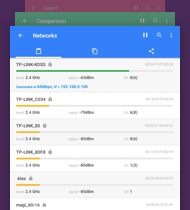

The results are displayed on a map that contains MAC address data, and that specifies non-passenger data categorized into pedestrians, vehicles, and buildings. Raw data obtained in the form of WiFi data and GPS data is combined and processed through five steps to produce non-passenger data. WiFi scanner devices are placed on two different buses for comprehensive monitoring of the route's operating hours. The method uses WiFi and GPS MAC addresses as raw data from WiFi devices, collected during the time the bus goes around the route. This study uses onboard WiFi scanners, circulated on the "Romango Bus", a hop-on-hop-off bus that has nine bus stops with roaming time from 09.50 to 17.50. Many previous studies have interpreted MAC address data into other forms for use in infrastructure development and urban transport. WiFi is one of the most useful technologies that can be used for detecting and counting MAC addresses. The paper also introduces technologies related to the IoT such as ubiquitous and pervasive computing, the Internet of Nano Things (IoNT), and the Internet of Underwater Things (IoUT). This is in addition to discussing research directions in each area. They are tracked back to their inception as much as possible. Accordingly, this paper attempts to disambiguate those paradigms and explain how and where they fit in the above three areas of research and/or their intersections before it becomes a serious problem. Unfortunately, those paradigms suffer from the lack of standard definitions, and so we frequently encounter a single term referring to various paradigms or several terms referring to a single paradigm. These include Mobile Cloud Computing (MCC), cloudlet computing, mobile clouds, mobile IoT computing, IoT cloud computing, fog computing, Mobile Edge Computing (MEC), edge computing, the Web of Things (WoT), the Semantic WoT (SWoT), the Wisdom WoT (W2T), opportunistic sensing, participatory sensing, mobile crowdsensing, and mobile crowdsourcing. Numerous emerging computing paradigms related to those areas of research and/or their intersections have come into play. The Internet of Things (IoT), which is concerned with building a network of Internet-enabled devices to promote a smart environment, is another promising area of research. Cloud computing and mobile computing are two prominent research areas that have already had such an impact. A comparison between passenger volumes obtained from the Wi-Fi data processing procedure and the data obtained using the ground truth procedure indicates the number of passengers determined using the Wi-Fi data acquisition and processing procedure is less than the number of passengers determined using the ground truth procedure.Ĭurrently, we are experiencing a technological shift, which is expected to change the way we program and interact with the world. The approach developed in the proposed study is capable of producing outputs, such as an origin-destination (OD) matrix and passenger volume for a bus route section. This study also describes a new data cleaning procedure that is used to characterize bus passenger volume and travel trends using a combination of MAC address and GPS data. This Wi-Fi scanner is capable of engaging a probe request mode to capture MAC addresses from mobile devices or other Wi-Fi-enabled modalities without connecting to the internet. This study aims to obtain media access control (MAC) addresses of individual bus passengers by using a Wi-Fi scanner. Transportation data retrieval using information technology, such as Bluetooth, Wi-Fi, and smartcards, is prominent. The procedure determined how many passengers traveled and explained which bus passengers used based on travel time.Ĭurrently, transport survey methods are very diverse. This procedure, using point to path-GIS, produced 70,000-80,000 raw data points cleaned into 100-130 new data points. The paper describes the procedure of the time travel estimation for each MAC address using the “point to path” analysis in QGIS open source software. The survey was conducted for one day (eight hours). The WiFi scanner was placed inside the bus to capture all the MAC addresses inside and around the bus. The MAC address is a unique ID for each device used such as mobile phones, smartphones, laptops, tablets, and other WiFi-enabled equipment.

This paper describes our study, which first uses a WiFi scanner to capture media access control (MAC) address data of bus passengers’ WiFi devices and then identifies each MAC address travel time to confirm the bus passengers. At the same time, WiFi is a low-cost technology, which offers a longer survey time and is able to support the Big Data era. Currently, the development of WiFi is proliferating, especially in the field of transportation and smart cities.


 0 kommentar(er)
0 kommentar(er)
